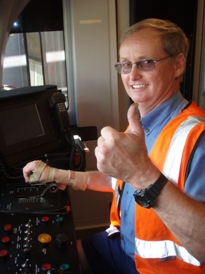Brisbane train driver fulfils dream
01, January 0001

It’s estimated that on any day, Queensland Rail City network services carry more than 170,000 customers to work, home, events and other destinations.
Perhaps you are one of them. Have you ever thought about the person who is driving you to work?
Meet John Denham. He’s a dedicated and committed Queensland Rail (QR) employee who’s been working in the rail industry for over 30 years and has been driving trains for nearly three. For John, driving trains is his passion.
But John, 57 isn’t your typical train driver for one fact; he has cerebral palsy. When John was just two years old he suffered a stroke which left him with dense paralysis on the entire right side of his body. He now has a marked limp and very limited use of his right hand on which he wears a specially designed splint.
When asked how his disability has affected his life John said: “I’ve been very fortunate, I grew up in a big family and I was never treated any differently because there was never enough time. We had a dairy farm when I was about 8 years old until I was 13. We were all expected to help,” he said.
“I don’t think I had any different challenges to any other kid growing up. I’ve never thought -Why me?”
John said that after working as a train guard for several years, becoming a train driver seemed like the next step. “I tend to forget that other people see me with a disability. I’ve driven some sort of machinery since I was 10 so I didn’t think there would be any problems. If anyone doubted me they don’t know me too well,” John said.
In 2008, John applied to become a train driver. He undertook the necessary written aptitude tests and a routine medical assessment, and was referred to a Brisbane Occupational Therapist (OT), Carmen Mitchell to determine his functional capacity for train driving duties.
Carmen admits that as an OT she felt professionally pressured. “Not only did I have to consider John’s rights to have equal access to employment opportunities, another key consideration in my professional assessment was the public’s safety,” she said.
“My decision was to move forward using a logical and informed process. I undertook a detailed job and task analysis to understand and determine the genuine occupational requirements, as required by the anti-discrimination legislation.”
The duties of a train driver are diverse and safety critical. They include operating a range of hand controls and this is where the first and major barrier was encountered. “Even though John could operate the power control lever using gross movements of his shoulder and elbow, he could not get adequate and reliable purchase with his right hand either with or without his usual splint,” Carmen said.
Using this information Carmen and another OT Jodie Copley, who specialises in working with people who have arm and hand problems after brain injury, formulated an action plan. The plan involved engaging Queensland Rail management and tradespersons in the design and manufacture of a stainless steel attachment for John’s hand splint that could potentially allow him to operate the power control lever more reliably.
When the prototype of the splint was finally developed, testing took place using the QR Train Simulator. Once Jodie and Carmen were satisfied John could safely and effectively control a train in the simulator, he was cleared to proceed in the practical aspects of the train driving program at Queensland Rail under close supervision of an experienced tutor driver.
In December 2008 John was able to fulfil his dream of becoming a train driver. “I learnt that if you put your mind to whatever you want to achieve, you can do it.”
Carmen said she was incredibly proud of John’s determination and self-belief. “As an occupational therapist I felt incredibly proud and privileged to facilitate a successful outcome which initially seemed impossible and improbable to many others,” Carmen said.
“I felt very grateful to Queensland Rail for providing the necessary support and resources which enable people with disabilities to have equal access and opportunity in their workplace. It wasn’t that long ago when an employer would be considered justified in refusing safety critical employment to a person with a disability such as John’s,” she said.
It’s been nearly three years since John’s first shift as a train driver and he couldn’t be happier. He’s an inspiration and proves that with hard work, dedication and perseverance anyone can achieve their dreams.
This year Occupational Therapy Australia Queensland division will be hosting the promOTing better living expo in Brisbane on October 28 and 29. This free event provides the public with an opportunity to learn more about the OT profession and the wonderful contribution OTs, like Carmen and Jodie are making in the community.
For more information visit Occupational Therapy Australia or contact (07) 3397 6744.
If you would like to interview John or Carmen please contact the media team at Invigorate on (07) 3870 5288.
Quick facts:
- According to the Australian Bureau of Statistics (ABS), 17.9% of Queenslanders, or just under 1 in every 5 people, have a disability.
- Research from the 2009 Survey of Disability, Ageing and Carers indicates that 4 million people in Australia (18.5% of the population) have a disability.
- Cerebral palsy is the most common form of childhood disability, affecting about 34,000 Australians.

